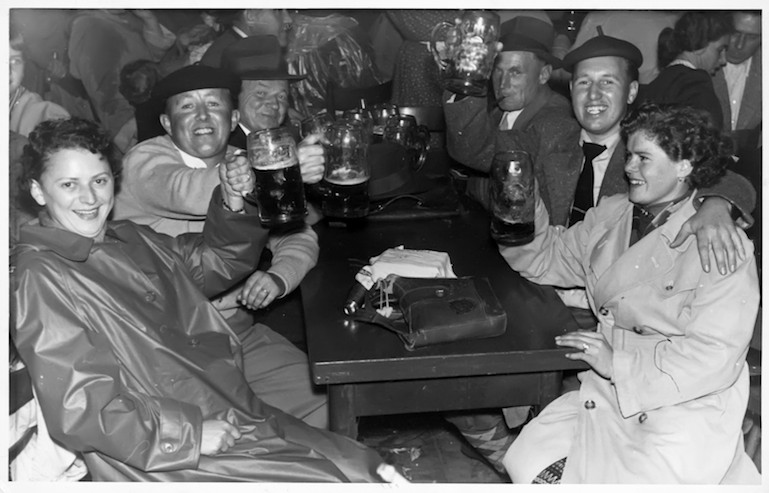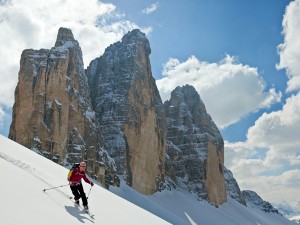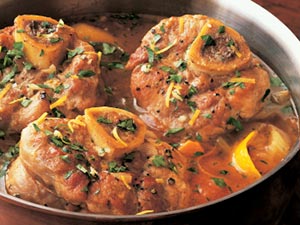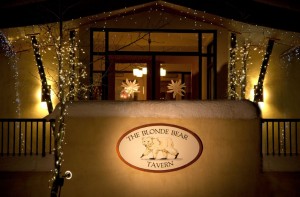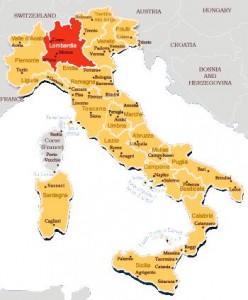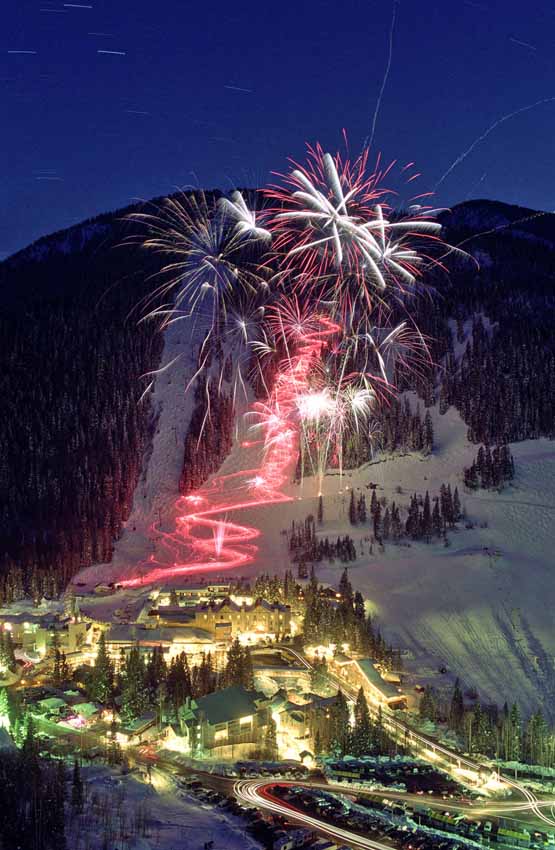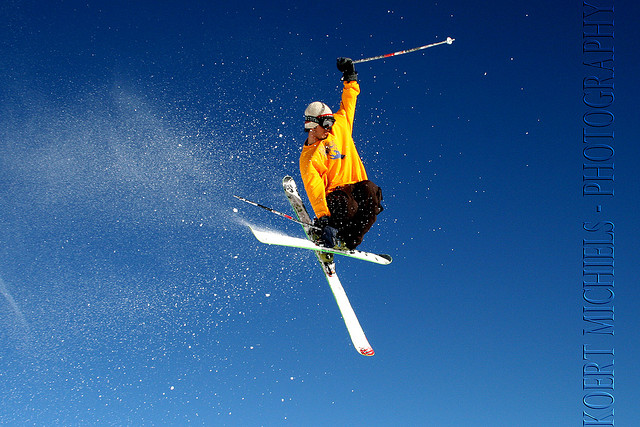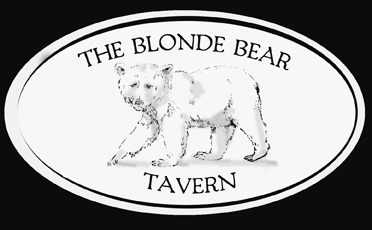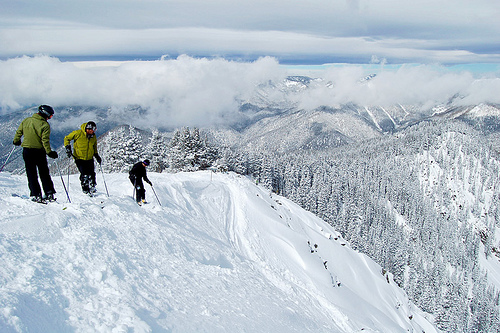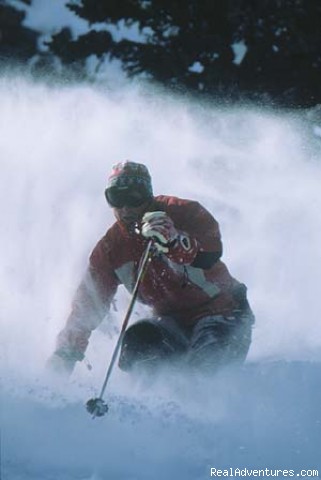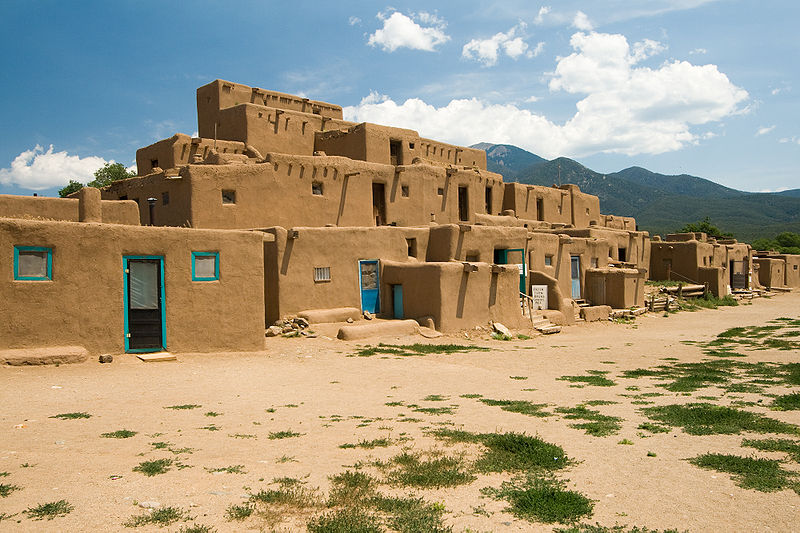- Andreas and Ingeborg Dirnagl (left) enjoying the 1957 Oktoberfest, Munich*
Oktoberfrest is a 16-day festival held each year in Munich, Bavaria, Germany. It runs from late September to the first weekend in October. Oktoberfest is one of Germany’s most famous events and is considered the world’s largest fair, with more than 5 million people attending every year. Countless communities across the world also celebrate this beer festival, and Taos Ski Valley is no exception! Our celebration is Saturday, September 15th.
.
History of Oktoberfest
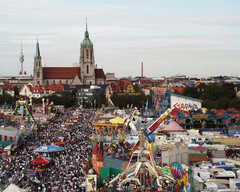
Crown Prince Ludwig, who later became King, married Princess Terese of Saxe-Hildburghausen on October 12, 1810. Everyone in Munich was invited to the festivities held on the fields at the city gates. The fields were named Theresienwiese (“Theresa’s Meadow”) in honor of the Princess. The locals refer to the field as Wies’n.
Horse races in the presence of the Royal Family marked the event’s closing that was celebrated as a festival for the whole of Bavaria. The decision to repeat the horse races in the subsequent year gave rise to the tradition of the Oktoberfest.
.
Two Classic Dishes
Along with the ubiquitous bratwurst, pretzels, and (of course) beer, there are two other dishes that abound during Oktoberfest season: Obatzda (cheese and beer dip on rye bread) and Datschi (fruit-topped cake).
I turned to The Blonde Bear Tavern’s Consulting Chef, Andreas Dirnagl, for these classic recipes (klassischen Rezepten). Andreas’s parents (pictured above) are Bavarian natives, who moved to the United States shortly after their 1957 marriage.
.
Obatzda
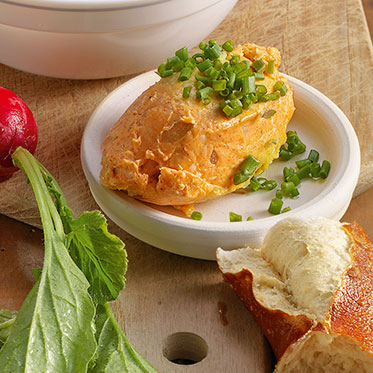
Chef Andreas gives us background:
A Bavarian specialty in the beer gardens, Obatzda is really more of a spread than a dip. Use a good hearty rye or dark bread (sliced works best). Place a slice of bread on a plate with a scoop of the spread on top. Garnish with onion, chive, and paprika. You can also serve radishes with salt and butter on the side. Yum!
.
Ingredients:
- 1 pound Camembert (or Brie) cheese, coarsely chopped
- 6 ounces cream cheese (or pungent Romadur), softened
- 1/4 cup unsalted butter, cut into small pieces
- 1/4 cup dark German ale
- 3 cloves roasted garlic
- 1 teaspoon caraway seeds
- 1 pinch sweet paprika
- salt and freshly-ground pepper
- 1/4 cup Spanish onions, finely diced
- 1 loaf rye or French bread
Preparing Obatzda
- Lightly toast the caraway seeds in a dry pan
- Place garlic in a small baking dish, drizzle lightly with olive oil, and season with salt. Pour a bit of water in the bottom of the dish, cover tightly with foil, and roast in 375° oven for about an hour.
- Place the Camembert in a medium bowl, add the cream cheese, butter, ale, garlic, and caraway seeds
- Add paprika, salt and pepper to taste; beat well to combine
- Take about 2/3 of the onions and sauté in olive oil until golden
- In a strainer, rinse the remaining raw onions under cold water; drain and transfer to a clean kitchen towel, squeezing out the liquid. Combine with sautéed onions
- Fold onion mixture into the cheese mixture
- Cover and refrigerate at least 2 hours, or up to 4 days.
Note: For a more authentic texture, set aside about 1/3 of the Camembert in a small dice and then fold it into the finished product. You may also use a bit of the rind.
.
Datschi
Datschi (pronounced dah-chi) is a Bavarian word that means any of a variety of fruit-topped cake. Again, Chef Andreas gives us background:
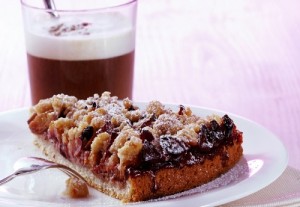
Commonality is that the dough is pressed into a straight sided pan (Datschi comes from the verb detschen, which means “to smoosh”). There is no rim built up on the edges of the dough, and it is topped with some form of fresh fruit. Streusel topping is optional. The dessert is served simply on a small plate, usually topped with a dollop of whipped cream.
These cakes are a mainstay of every Bavarian bakery and major open air festival, as they can be made in big sheets. Fruit topping is variable, although plum is the most common. If you want authenticity, you need Italian plums. Remember in baking – if it eats sour, it bakes sweet and vice versa. Italian plums look kind of like plum tomatoes (as opposed to regular plums, which are round) and are quite sour if you eat them raw. When you bake them they become sweet / sour.
This recipe is from my mom, Inge, and is quite common in the Bavarian neighborhood where she grew up:
.
Ingredients:
For the Cake
- 4 1/2 cups all-purpose flour, sifted
- 1 1/2 cups sugar
- 1 tablespoon vanilla extract
- 1 tablespoon baking powder
- 3 sticks unsalted butter, cubed at room temperature
- 2 eggs
- 1 1/2 tablespoons dark rum
- about 40 Italian plums, pitted and quartered
For the Optional Streusel
- 1 1/4 cups all-purpose flour
- 3/4 cups sugar
- 2 teaspoons vanilla extract
- 1/2 teaspoon cinnamon
- 1 stick unsalted butter, melted
.
Preparing Datschi
- Mix all the dry ingredients in the bowl of a food processor. Blend 30 seconds.
- Add the cubed butter and process until crumbly.
- Combine eggs, vanilla, and rum (it will look slightly curdled). Add to the food processor bowl and process until the dough just begins to form (it will look and feel like soft sugar cookie dough).
- Turn out and roll the dough, forming a thick log the length of a 26″ by 18″ “half sheet” pan. Place down the center of the pan and use your hands and knuckles to push dough into all corners and edges of the pan. It should be flat, with no “rim” on the sides.
- Place the fruit on top in a decorative, repetitive pattern (with an eye towards cutting servings into squares or rectangles.
- Bake in preheated 375 degree oven until the dough rises slightly between the fruit slices and the fruit has softened and begins to brown slightly, about 30 minutes.
- If not topping with the optional streusel, sprinkle with cinnamon sugar after about 10 minutes of baking.
.
For optional streusel:
- Combine all ingredients except butter, and mix well.
- Drizzle with butter, and using fingertips, combine to form streusel.
- Sprinkle over fruit topping before baking.
.
Variations:
If using apples, use a tart variety. Peel, core, and slice into about 1/2″ wedges. You can also use about a 1/4 inch layer of apricot or raspberry jam or jelly if you have no fruit on hand. If using jam or jelly topping, then streusel is no longer optional – rather double the streusel recipe and completely cover the jam/ jelly topping with streusel before baking.
.
Oktoberfest at Taos Ski Valley
This year looks to be the biggest and best Oktoberfest in Taos Ski Valley. And it’s FREE fun for all ages.
The day will feature an authentic Schuplatter band and dancers, German beer and food, activities for kids, Brat eating contest, Yodeling contest, Alpenhorn blowing contests, and more.
Our Village stores will be offering pre-season blowout prices on ski gear and sporting apparel.
- Festival Times: 11am to 6pm
- Christof Brownell 11am – 6pm
- Schuplatter Band 2pm – 6pm
- Comedy time with Petey Tang – 2pm
- Bouncy Castle, face painting and Family fun
.
*A Note about the Black and White Photo Above:
At my request, Andreas sent me an Oktoberfest picture with his mom (whose Datschi recipe she graciously shared) and dad (who is now deceased). He sent the following accompanying message, which I think bears repeating:
The year was 1957 and Mom was 28. This is Oktoberfest as it used to be. Mom is on the left with my dad immediately behind her. They would have been married all of 4 months at this point. Behind my dad is my grandfather (mom’s dad). The woman on the right is my Aunt Maria and the man with his arm around her shoulder is her husband, my Uncle Siegried (my dad’s brother). The other man is a stranger who photo bombed the picture.
Mom says that she and my Aunt went for a walk to see the sights at Oktoberfest and the men stayed back in the tent to save the seats. By the time they got back, the men were ripped and as she passed by to sit down my uncle grabbed her beret and wore it for the picture.
